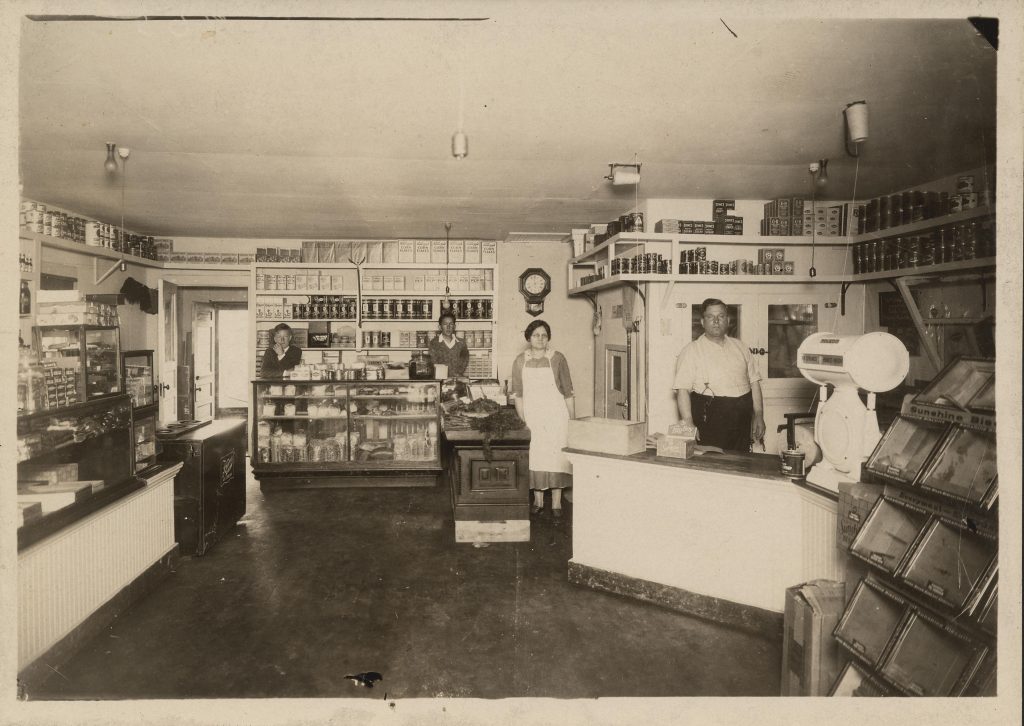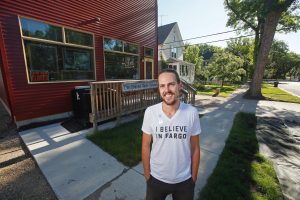
Reposted from The Forum of Fargo-Moorhead, August 10, 2016
By Tu-Uyen Tran
Photo from NDSU Archives: Julius Lommen and his wife stand at the counter in their grocery store at 9 Sixth Ave. N. near Oak Grove Park in Fargo in this photo from the 1930s. It later became a restaurant called Chicken Delight and is now a private home. Photo source: NDSU Archives.
The little workshop, its windows filled with stained glass, looked a little out of place on the quiet residential street here in the Hawthorne neighborhood.

Joe Burgum is president of the Hawthorne neighborhood association and is encouraging the city to have policies to promote walkable neighborhoods.
David Samson / The Forum
It’s not just that there aren’t any other businesses on the street. It’s that, with a false front, the building looked like an Old West saloon had been dropped among the gabled houses.
Joe Burgum, a member of the neighborhood association, said the Stained Glass Workshop was once a grocery store, one of many that area residents could walk to. That’s the way it used to be in most Fargo-Moorhead neighborhoods, he said.
Burgum is an advocate for a nationwide movement called New Urbanism that rejects the suburban development model that’s been dominant since the 1950s. Suburbs designed around cars don’t encourage neighbors to get to know one another like older neighborhoods designed around pedestrians, which weakens the fabric of the community, they argue.
What older neighborhoods got right, they say, is narrow streets that reduce traffic speed and increase pedestrian comfort; parks and schools within walking distance; and zoning that allows shops within neighborhoods.
Burgum said his ideal is “if people can live their lives from home and take a number of trips without using their cars.” It’s a concept Fargo city planners have long endorsed.
But there is a limit to the lessons the past can teach, as the popularity of neighborhood businesses, at least in Fargo-Moorhead, has historically been narrow.
RELATED: Fargo should stop getting bigger and start getting denser, Burgum says
The good old days
In 1948, a few years before suburbanization took off and private cars became the main way people got around, Hawthorne alone had 12 grocery stores, according to that year’s city directory. No resident of this half-square-mile neighborhood just south of downtown needed to walk more than a quarter mile to get to a store.
Island Park Grocery, the one that would become the stained-glass workshop, was owned by Elmer Ericson, known as Fargo’s “friendly grocer,” said a 1949 Forum story about his retirement. The Barnesville, Minn., native, dreamed of becoming a dentist but ended up running grocery stores.
Island Park Grocery, which had been a grocery store since it was built in 1895, later became, among other things, an electrician’s shop, a dance studio and book store.
Hawthorne was not all that unusual. There were nearly 120 grocery stores across Fargo and Moorhead, about 22 for every 10,000 residents. Today, with vastly bigger stores offering a greater variety of goods in centralized locations, there are about two for every 10,000 residents. None are located in the middle of residential areas.
According to local historian Dawn Morgan, most families didn’t have cars during World War II and, even if they did, women, who did most of the shopping, seldom learned to drive. The other key demographic for stores, candy-loving kids, also didn’t drive.
Morgan said many of these neighborhood stores endured into the 1960s because few women drove even then.
Because so many residents went to the same stores, they became gathering places where neighbors would catch up with one another’s lives, said Paul Harris, a historian at Minnesota State University Moorhead who was involved in preserving the Old South neighborhood near the university.
So popular were these stores, he discovered, that a good location within a neighborhood was often able to support more than one. In the Old South neighborhood, where he used to live, there had been three within a block of one another at one time.
Downtown-centric
But aside from the grocery stores, Fargo-Moorhead neighborhoods in 1948 had few, if any, other kinds of businesses residents might regularly visit.
There were usually no cafes, drug stores, hardware stores, barber shops or beauty parlors. More often than not, residents would’ve had to head downtown to get to those.
Compared to today, the retail and service industries in 1948 were centralized to a remarkable degree. Nearly 90 percent of Fargo’s 31 barbershops and all six of Moorhead’s barbershops were in the cities’ downtown.
Based on a review of city directories, the dynamic was similar in 1928, in the boom years toward the end of the Roaring Twenties and before the Great Depression, and 20 years later in 1968, though home-based beauty parlors had become a common neighborhood business in 1968.
Three quarters of the cities’ restaurants were in their downtowns in 1948. Such businesses are today spread out along major commercial corridors within easy reach of drivers.
There wasn’t a huge demand for them within neighborhoods in the old days, according to Mark Peihl, an archivist with the Historical and Cultural Society of Clay County.
“Going out was something fairly special,” Peihl said. “Unless you’re a guy working downtown some place. Rather than drive all the way home or walk all the way home to have lunch with your wife and family you might go to a restaurant.”
Meaning of ‘walkable’
When people talk about walkability today, it means something different than it did nearly 70 years ago, before strip malls and interstates.
Though he himself enjoys long walks, Burgum said he considers 10 minutes or half a mile about the farthest most people would be willing to walk.
Walk Score, a website that helps renters find walkable neighborhood, said it gives the most points to areas with amenities within five minutes or a quarter mile, though amenities as far off as 30 minutes can still earn some points.
Hawthorne, being close to downtown, got 59 points, making it “somewhat walkable.” The average in Fargo is 43 and, in Moorhead, 31, making them “car-dependent” cities.
In 1948, though, most residents would’ve considered downtown very much within walking distance — the southern edge of Fargo was only about a mile and a quarter from downtown and the northern edge about a mile and a half. And there was always the bus; the famed streetcar lines were long dead by then for lack of profit.
Downtown Moorhead was also within walking distance for most residents, Peihl said.
“In the past, people simply walked more than we do today. The streets were narrower and the traffic was less intense, slower and it made for pleasant walking I’m sure,” he said.
Changing policies
Promoting walkability isn’t a new thing in Fargo. Nearly two decades ago, the city changed zoning codes to allow offices and stores located in residential neighborhoods, the kind of mixed use that New Urbanists praise.
“The general planning principle is that you have neighborhood services so that we can encourage that walkability and neighborhood character,” said Planning Administrator Nicole Crutchfield.
The idea is to encourage the way things used to be in the postwar years, when a resident could go to the corner shop for a loaf of bread.
But there have been few takers, which may suggest the market isn’t yet there. Only 22 lots out of more than 31,000 in the city have the neighborhood business zoning, and none provide goods and services that residents might require regularly.
Crutchfield said it might be that circumstances aren’t right yet. Not all properties are appropriate, she said, and developing within an existing neighborhood, which may include renovating an old house, requires a lot of work and creativity. She added that the city sometimes uses zoning for denser commercial areas in neighborhoods but places restrictions on them.
Burgum said he suspects many entrepreneurs aren’t aware of the zoning and don’t know to ask. In some cases, he said, neighbors may oppose such businesses fearing they would lead to parking and traffic problems. He doesn’t think they would be because of their small size.
But there are signs neighborhood businesses are coming back.
While campaigning for Fargo City Commission in a losing bid in June, Burgum said he stumbled on a building filled with Somali businesses in a residential area dominated by Somalis, many of whom didn’t drive. There were restaurants, a travel agency, a tailor and other services all within walking distance for the New Americans, he said.
“I want one of these in every single neighborhood,” he said remembering how thrilled he was to see it happening. “There’s such an energy about it. It was just so cool to see.”
Click here to see an online map of Fargo-Moorhead business locations in 1928, 1948, 1968 and now.